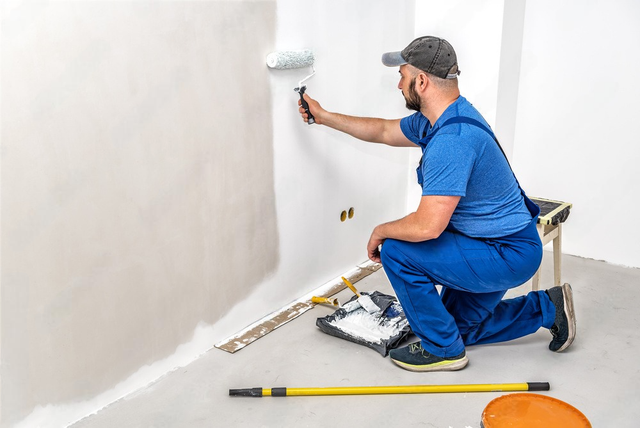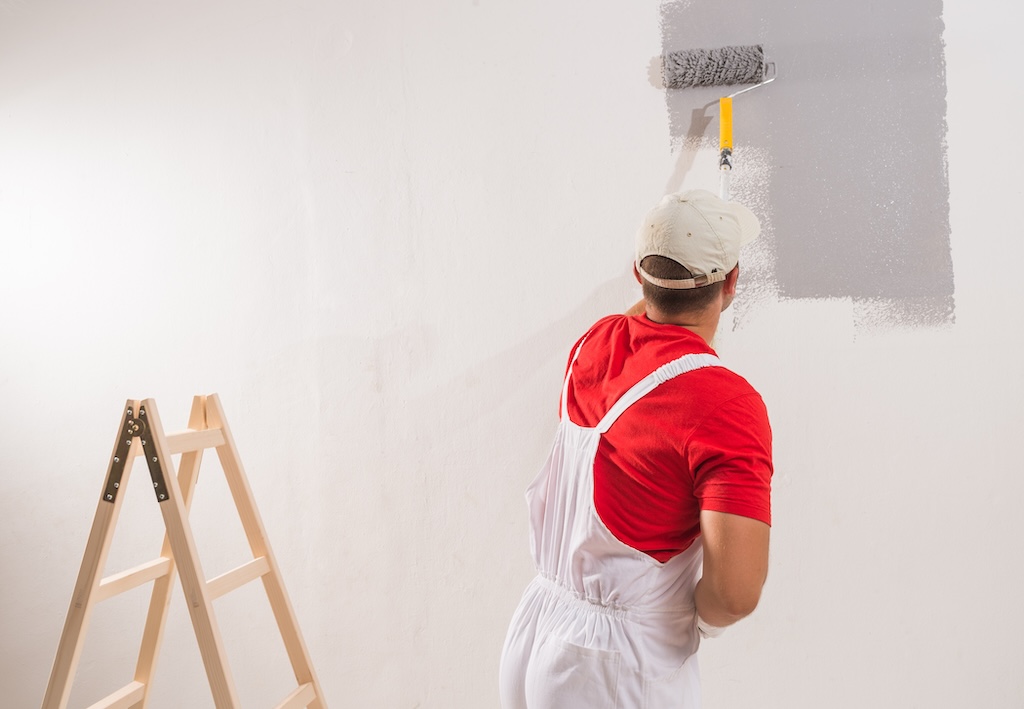Discovering the Different Kinds Of Paint: An Overview for each Project
Discovering the different types of paint is essential for attaining the desired end result in any type of task. From water-based choices that offer benefit to oil-based paints understood for their resilience, each selection has its advantages. Specialized paints can add one-of-a-kind structures or coatings, while environment-friendly alternatives satisfy those seeking sustainability. Comprehending these differences can considerably impact the success of a paint endeavor. What variables should one take into consideration when making the best selection?
Recognizing Paint Kinds: Water-Based vs. Oil-Based
Paint kinds can significantly impact a job's outcome, and comprehending the distinctions between water-based and oil-based paints is essential for notified decision-making. Water-based paints, commonly referred to as latex paints, are made up of water as the primary solvent. They dry swiftly, emit fewer unstable natural substances (VOCs), and are easy to tidy up with soap and water. This makes them a prominent choice for interior applications and environments where air top quality is a problem.
In contrast, oil-based paints utilize natural solvents, offering a long lasting, shiny coating perfect for surfaces subjected to use and tear, such as trim and closets. They take longer to completely dry, require mineral spirits for cleanup, and have a stronger odor. paint store corpus christi tx. Choosing between these two types depends on the particular needs of the job, thinking about elements such as desired surface, application atmosphere, and convenience of upkeep. Each type has distinct advantages and constraints, leading the option procedure
The Complete Matters: Selecting Between Matte, Satin, and Gloss
When selecting a paint finish, the selection between matte and glossy options greatly influences both aesthetics and functionality. Matte surfaces provide a subtle, non-reflective look that can conceal surface area imperfections, while shiny coatings offer durability and ease of cleansing. Understanding the advantages and factors to consider of each can assist in making a notified choice for any painting project.
Matte Finish Advantages
Although several home owners discuss the benefits of various finishes, matte paint offers distinctive benefits that make it a popular selection for both exterior and interior applications. Among the primary advantages of matte finish is its capability to hide surface blemishes, developing a smoother appearance on wall surfaces. This high quality is specifically advantageous in older homes or rooms with unequal surface areas. Additionally, matte paint soaks up light rather than mirroring it, which can enhance the aesthetic of an area by supplying an extra soft and innovative appearance. Furthermore, matte coatings are frequently less complicated to repair than glossier choices, as they can mix much more flawlessly when applied over existing paint. On the whole, matte paint is an excellent option for those looking for a refined and stylish surface.
Shiny End Up Factors To Consider
A glossy surface can dramatically alter the understanding of an area, using a reflective and sleek top quality that enhances both color vibrancy and light within a room. This surface is commonly favored for high-traffic areas and surface areas like bathroom and kitchens, where durability and ease of cleansing are necessary. Its reflective nature can highlight blemishes on wall surfaces, making correct surface area prep work essential. Shiny paints additionally tend to reveal smudges and fingerprints more conveniently, demanding normal upkeep. In addition, lights plays a substantial function; in brilliant atmospheres, a glossy surface may develop glow, influencing the total aesthetic. Mindful factor to consider of the specific application and atmosphere is essential when choosing a shiny surface for any task.
Specialized Paints: When to Use Distinctive or Chalk Paint
Specialty paints, such as textured and chalk paint, deal one-of-a-kind visual and useful advantages that can improve various surfaces. Distinctive paint is suitable for producing deepness and dimension on walls, hiding imperfections while including a three-dimensional feeling. It is particularly advantageous in high-traffic locations where resilience and aesthetic rate of interest are essential.

Both kinds of specialty paints can change areas, yet picking the appropriate one relies on the wanted impact and surface demands. Textured paint may suit larger areas, while chalk paint can revitalize smaller sized things, showcasing creative thinking and individual style in any project.
Outside Paints: Safeguarding Your Surfaces From the Elements
Outdoor paints are essential for safeguarding surface areas against different climate condition. Recognizing their climate resistance functions, proper surface area prep work needs, and reliable application methods can significantly enhance durability and efficiency. This area will certainly outline vital factors to consider for selecting and making use of outside paints efficiently.
Climate Resistance Includes
Weather resistance is an essential function of exterior paints, as it determines just how well surfaces can withstand the extreme aspects of nature. High-grade outside paints are developed to resist damage from UV rays, dampness, and temperature variations. UV resistance assurances shades remain lively with time, avoiding fading and staining. Moisture resistance secures versus mold and mold, which can compromise the honesty of surfaces. In addition, paints with outstanding temperature level resistance can acquire and expand without breaking, keeping their protective top qualities. When picking exterior paints, it is essential to take into account these climate resistance features, as they add to the long life and sturdiness of coloured surfaces, ensuring they continue to be aesthetically pleasing and practical regardless of direct exposure to the elements.
Surface Prep Work Requirements
Appropriate surface area prep work is a basic action in accomplishing the most effective outcomes with outdoor paints. To ensure excellent adhesion and resilience, surface areas need to be extensively cleaned, removing grease, dirt, and mildew. This can be accomplished using a pressure washer or a scrub brush with an appropriate cleansing option. As soon as cleansed, surface areas need to be evaluated for any kind of peeling or flaking paint, which must be scraped away to produce a smooth structure. Fixing any type of fractures or holes is also important, as these can permit dampness seepage. Furthermore, sanding rough areas promotes better paint adhesion. Applying a primer matched for outside use can boost the paint's performance, assuring a resilient surface that withstands the components. Appropriate preparation is vital to an effective outdoor paint job.
Application Methods Tips
While applying outside paints, it is important to utilize reliable methods that guarantee surface areas are well-protected versus the components. Select the best day for painting; reduced humidity and light temperatures boost bond and drying out. Prepping the surface area thoroughly-- cleansing, fining sand, and priming-- guarantees much better paint adhesion and toughness. Using high-grade brushes or rollers can provide a smoother finish, while spray painting might cover large locations efficiently. Using paint in slim, also layers stops drips and runs. It is a good idea to see follow maker instructions concerning drying times between layers. Verify correct air flow throughout application to help with drying out and minimize exposure to fumes. These methods considerably boost the longevity and efficiency of outside paint.
Eco-Friendly Options: Low-VOC and Zero-VOC Paints
As customers become increasingly knowledgeable about the ecological effect of their choices, zero-voc and low-voc paints have actually emerged as popular options. These paints are developed to have less unstable organic substances (VOCs), which are chemicals that can vaporize right into the air and contribute to air pollution and health issue. Low-VOC paints commonly contain a restricted quantity of VOCs, while zero-VOC paints have minimal degrees, making them more secure for both outside and indoor use.
The benefits of utilizing low-VOC and zero-VOC paints extend beyond environmental considerations; they likewise enhance indoor air high quality, lowering the risk of allergic responses and respiratory system concerns. Several manufacturers now offer a selection of shades and surfaces in green options, making it simpler for consumers to find ideal items for their tasks. By selecting these paints, individuals can add to a much healthier atmosphere while still achieving the visual they desire in their areas.
Tools and Techniques for a Flawless Application
Achieving a remarkable paint application requires the right devices and techniques, which can significantly enhance the result. Choosing the suitable brush or roller is vital; brushes work well for sides and complex locations, while rollers cover bigger surfaces efficiently. Making use of high-grade products guarantees far better paint distribution and minimizes touches. For excellent results, surface area preparation is essential. This consists of cleaning, fining sand, and priming surfaces to promote attachment.
Strategy likewise plays a substantial role. The "W" approach with a roller helps to equally distribute paint, while long, smooth strokes with a brush stop visite site visible lines. Working in areas enables for far better control and blending. In addition, applying slim coats is more effective to thick layers, decreasing the threat of drips and unequal textures. Lastly, keeping a wet side during application assists achieve seamless adjustments between locations. By integrating these devices and techniques, one can attain a expert and refined coating.
Tips for Preserving and Taking Care Of Your Painted Surfaces
Proper upkeep and care of painted surfaces can considerably extend their life-span and maintain their appearance. Routine cleansing is vital; making use of a soft fabric or sponge with moderate soap and water can get rid of dirt and dust without harming the paint. It is advisable to prevent abrasive cleaners or scrubbing pads, as these can scrape the surface. In addition, using a fresh layer of paint every couple of years can protect and revitalize the color against wear.
For outside surface areas, evaluating for indicators of peeling off or fading consistently is necessary. Quickly addressing any problems protects against additional damages. In areas prone to dampness, such as shower rooms, making use of mold-resistant paint and making certain correct air flow can aid keep the honesty of the paint. Utilizing safety coatings can secure versus UV rays and stains, ensuring that repainted surface areas stay vibrant and enticing for years to come, eventually enhancing the overall visual of the room.

Often Asked Inquiries
Can I Mix Different Kind Of Paint Together?
Mixing different kinds of paint is typically not suggested, as it can bring about issues like weblink bad attachment, irregular texture, or unanticipated chain reaction. It's best to utilize compatible paints for suitable outcomes and resilience.

How Do I Effectively Shop Extra Paint?
To properly save remaining paint, seal the container tightly, tag it with the date and shade, and maintain it in a great, dry location away from straight sunshine and extreme temperature levels for suitable preservation.
What Is the Best Means to Get Rid Of Extra Paint?
The best means to throw away unused paint is to inspect neighborhood regulations, as lots of locations have assigned contaminated materials centers. Additionally, consider contributing usable paint to neighborhood organizations or institutions for their projects.
Just How Can I Tell if Paint Is Still Good to Use?
To establish if paint is still good, analyze its shade, smell, and uniformity. If it shows up apart, has an undesirable smell, or reveals considerable adjustments in texture, it's likely no more functional.
Exist Age Restrictions for Buying Paint Products?
In lots of regions, there are no details age restrictions for acquiring paint products. Some shops might require customers to be at least 18 years old, especially for items consisting of solvents or unsafe materials.
Paint types can noticeably affect a task's end result, and understanding the distinctions in between oil-based and water-based paints is necessary for notified decision-making. Water-based paints, typically referred to as latex paints, are made up of water as the main solvent. In contrast, oil-based paints utilize natural solvents, supplying a sturdy, shiny coating perfect for surface areas revealed to put on and tear, such as trim and cabinets. Specialty paints, such as textured and chalk paint, offer distinct visual and functional benefits that can boost various surfaces. In locations prone to wetness, such as restrooms, making use of mold-resistant paint and guaranteeing proper ventilation can help keep the honesty of the paint.